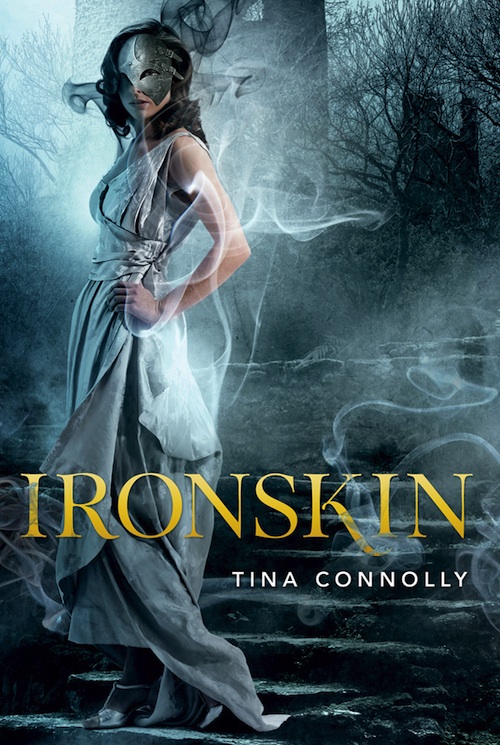I was actually already through two-thirds of Tina Connolly’s Ironskin, before I realized that I was reading a fantasy version of Jane Eyre. Of course, to anyone paying attention, this fact is obvious; the story centers around protagonist Jane Eliot, who comes from London to a country house on the moor to become a governess to the daughter of Edward Rochart. I suppose I can only plead the fact that I was so caught up in the magic of Connolly’s world that I hardly noticed anything else. The fey of this magical England are mysterious and imaginative, and if I have any complaint about them, it is that I wanted more.
Jane is the survivor of a war between humans and the mysterious and ethereal fey. During the war, the fey used strange bombs to kill human soldiers so that they could enter the bodies through the wounds and possess the dead. Jane bears the scar of one of those bombs on her face, and, like all such wounded, wears iron over the mark to contain the curse it left behind; a curse that bleeds out in two directions, filling both Jane and the people around her with fierce, unrelenting anger.
I have to say, given the fact that she was cursed with magical rage, Jane never seems particularly angry to me. And when she is angry, it is usually entirely justified, as when she feels upset or threatened by people’s reaction to her injury and heavy iron mask, or frustrated by the difficulty in teaching Edward’s stubborn, fey-spirited daughter, Dorrie. I would have liked to see the idea of Jane being truly rage-filled taken farther in the narrative, especially since it is an unusual trait to see bestowed on a woman in these sorts of tales. Still, what is used is very good, and the plot of Jane’s struggle to control, and then to understand, her curse, was possibly my favorite part of the book.
Another interesting aspect is the puzzle of Edward Rochart and his mysterious studio, into which ugly woman would disapear, only to reemerge “as beautiful as the fey.” Although I don’t find him as entrancing as Jane did—a lot of his character is delivered by Jane telling us what he was like, rather than allowing us to observe him, so the impressions weren’t as powerful as they could have been—the question of just what the artist gets up to in his studio hangs tantalizingly over the reader, and we know it will be important sooner or later.
Dorrie, Rochart’s strange pixie of a daughter, is far more interesting than the aloof figure of Edward himself, and an interesting foil to Jane’s character. I enjoyed the way Jane learns to understand herself and her curse through Dorrie and the child’s own fey talents, and the development of the two girls’ relationship is dynamic and organic in a way that makes Jane’s affection for Dorrie play much better than her love for Edward.
Connolly’s use of the fey and the place of magic in her world is one of the more interesting and imaginative executions I’ve seen, and when the fey make their reappearance—which the reader has of course been eagerly awaiting the entire time—the tale takes an unexpectedly harrowing turn into fantasy horror, which I absolutely loved. I only wish it had gotten there sooner, spending less time in the slowly-unfolding Jane Eyre plot and more time in Connolly’s dark magical world.
Despite my difficulties with the portayal with Edward as a rather one-dimensional love interest, the supporting cast, including Edward’s small but unusal staff of servants and Jane’s sister, Helen, were interesting people in their own right, and well fleshed-out. Connolly’s visual discriptions, both of people and of the settings in which they find themselves, are vivid and delivered in a simple but refreshingly imaginative prose that finds ways to evoke powerful images without ever relying upon tropes or cliches, and the climatic ending and Jane and Edward’s roles in it go a long way to assuaging the places I felt their development may have faltered in the middle of the story. I definitely recommend this book to imaginative readers, and am looking forward to the sequel.
Kelsey Jefferson Barrett is a writer and a reader and a lover of fantastic horror. They live in Brooklyn and studies at Drew University; you can follow them on Twitter and read their short story “My Teacher, My Enemy” at Lightspeed Magazine.










